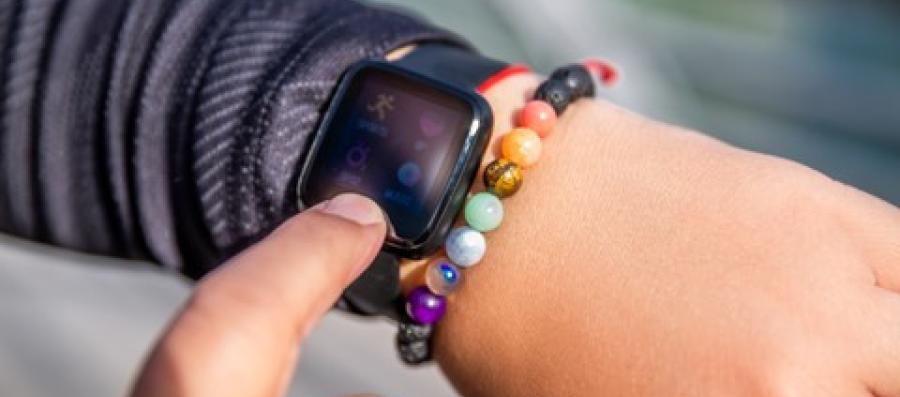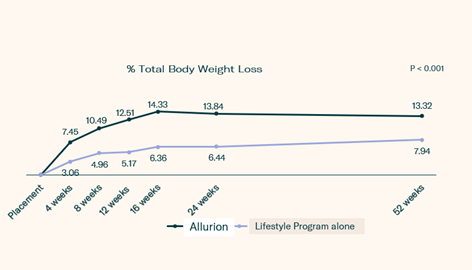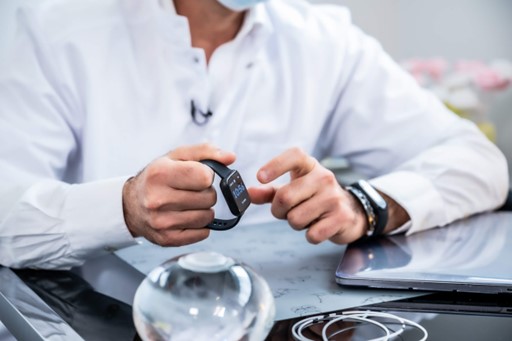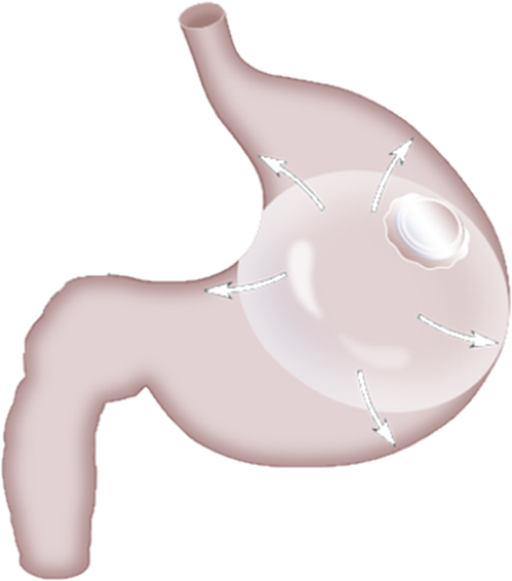Is the Allurion Program more effective than dieting alone?

In short – Yes! Let us explain….
We know that weight loss is not easy. You need the right tools and support on your side. The evidence is clear; “diet and exercise” alone is not enough. The best results in terms of achieving meaningful weight loss come from those who used a weight loss service; you need a more holistic, medical approach.
While there are a range of effective and sustainable weight-loss treatments, what’s consistent in all of them is taking steps to change your lifestyle habits and behaviors, as well as your diet and physical activity. In fact, a more holistic lifestyle change approach is recommended around the world as the cornerstone to any weight-loss treatment even medical or surgical options1-7. It’s the combination of all these elements that delivers optimal results, not doing any of them in isolation.
Did you know that the Allurion Program leads to nearly 2.5x the weight loss than a lifestyle change program alone?

Research shows that the Allurion Program (a combination of our unique swallowable gastric balloon and a supported lifestyle change program) achieves significantly better results than a lifestyle change program alone. Other studies on Intragastric Balloons tell the same story; they achieve significantly superior weight loss vs diet alone.9

What’s worrying, Zoe Griffiths Registered Dietitian and Director of Global Nutrition at Allurion comments, is that not only have the majority of adults tried to lose weight in the last 12 months (depending on the county it could be anything from 50-80%)10,11 , but that most are unsuccessful. Studies underscore the need for increased support and solutions for weight management.
One study11 shows that the most common weight loss methods people use are calorie-controlled or restricted diets (72% of participants), exercise programs or courses (22%), and pharmaceutical treatments (12%). However, three-quarters of participants who attempted to lose weight within the past year, did not achieve a clinically meaningful weight loss defined as at least 5% of their body weight.
In another study10, the most commonly reported weight loss methods were exercising (63%) and eating less food (63%), followed by consuming more fruits, vegetables, and salads (50%).
The evidence shows that exercise and calorie-controlled or restricted diets are the least beneficial, with respect to achieving clinically meaningful weight loss. These isolated methods alone are not enough.
The Allurion swallowable Balloon supports your weight-loss efforts in a powerful way; it’s a tool to help you make changes to your lifestyle delivering:
- Increases in satiety: You feel fuller for longer
- Reductions in hunger: You feel fuller quicker,with smaller portions

With these benefits on your hunger and satiety, adopting changes to your diet and activity is much easier; kick starting sustainable changes to your lifestyle.
The Allurion Program offers an evidence-based Program that combines medical, digital and nutritional approaches and engages an entire team to empower you to jumpstart your weight-loss and form lifelong healthy habits.
You get the best of both; a tool to help you lose weight while feeling full, and a supported lifestyle change program customized to your preferences and needs. This combination helps you achieve greater results with less struggle.
References
1. Behavioral Weight Loss Interventions to Prevent Obesity-Related Morbidity and Mortality in Adults: US Preventive Services Task Force Recommendation Statement.US Preventive Services Task Force., Curry SJ, Krist AH, Owens DK, Barry MJ, Caughey AB, Davidson KW, Doubeni CA, Epling JW Jr, Grossman DC, Kemper AR, Kubik M, Landefeld CS, Mangione CM, Phipps MG, Silverstein M, Simon MA, Tseng CW, Wong JB. JAMA. 2018 Sep 18; 320(11):1163-1171.
2. Wadden TA, Tronieri JS, Butryn ML. Lifestyle modification approaches for the treatment of obesity in adults. Am Psychol. 2020;75(2):235-251. doi:10.1037/amp0000517
3. Garvey WT, Mechanick JI, Brett EM, Garber AJ, Hurley DL, Jastreboff AM, … Reviewers of the AACE/ACE Obesity Clinical Practice Guidelines. (2016). American Association of Clinical Endocrinologists and American College of Endocrinology comprehensive clinical practice guidelines for medical care of patients with obesity. EndocrinePractice, 22(Supplement 3), 1–203.
4. Jensen MD, Ryan DH, Donato KA, Apovian CM, Ard JD, Comuzzie AG, … Yanovski SZ (2014). Guidelines (2013) for managing overweight and obesity inadults. Obesity, 22(S2), S1–S410.
5. World Health Organization. (1998). Obesity: Preventing and managing the global epidemic (Publication No. WHO/NUT/NCD/98.1). Geneva: Author.
6. NICE Obesity: identification, assessment and management. Clinical guideline [CG189]Published: 27 November 2014
7. Weight management: lifestyle services for overweight or obese adults. Public health guideline [PH53]Published: 28 May 2014
8. *Results at 16 weeks. Raftopoulos, I et al Holyoke Medical Center. Holyoke, MA An Intensive 52 Week Nutritional, Exercise and Behavior Modification Program: Comparing With or Without the Allurion IGB Presented at ASMBS 2019
9. Genco A, Balducci S, Bacci V, et al. Intragastric balloon or diet alone? A retrospective evaluation. Obes Surg. 2008;18(8):989-992. doi:10.1007/s11695-007-9383-9
10. Products - Data Briefs - Number 313 - July 2018 (cdc.gov)
